Impact of Blank Holding Force and Friction on Springback and Its Prediction of a Hat-Shaped Part Made of Dual-Phase Steel
Abstract
1. Introduction
2. Materials and Methods
2.1. Material
2.2. Experimental Setup
2.3. Simulation Setup
2.3.1. Yield Criteria
2.3.2. Hardening Rules
- Hollomon
- Krupkowski
3. Results
3.1. Analysis of Springback Results from Experiments
3.2. Analysis of Springback Prediction Results
4. Discussion
5. Conclusions
- Blank holding force has an impact on the springback of the hat-shaped part, when lower values of blank holding force were applied on the blank during forming, then less springback of the part was observed and lower forming force FF was measured. Hat-shaped parts made with the use of the weakest springs experienced a 10% reduction in springback compared to parts produced with the strongest springs.
- The use of PE foil as a lubricant can reduce the springback effect by up to 8%.
- The Yoshida-Uemori hardening rule showed more accurate predictions of springback in a limited number of cases compared to isotropic hardening rules. Accuracy of springback predictions is impacted by friction, BHF, hardening rules, and yield criteria.
- Springback predictions were more accurate for parts made with the lowest values of blank holding force when a higher value of friction coefficient was used. Parts made using the highest values of blank holding force showed more accurate springback prediction when lower friction was applied in simulation.
Author Contributions
Funding
Institutional Review Board Statement
Informed Consent Statement
Data Availability Statement
Conflicts of Interest
References
- Jeswiet, J.; Geiger, M.; Engel, U.; Kleiner, M.; Schikorra, M.; Duflou, J.; Neugebauer, R.; Bariani, P.; Bruschi, S. Metal forming progress since 2000. CIRP J. Manuf. Sci. Technol. 2008, 1, 2–17. [Google Scholar] [CrossRef]
- Chongthairungruang, B.; Uthaisangsuk, V.; Suranuntchai, S.; Jirathearanat, S. Springback prediction in sheet metal forming of high strength steels. Mater. Des. 2013, 50, 253–266. [Google Scholar] [CrossRef]
- Trzepieciński, T. Forming processes of modern metallic materials. Metals 2020, 10, 970. [Google Scholar] [CrossRef]
- Masato, U. Joining technologies for automotive steel sheets. Weld. Int. 2011, 25, 249–259. [Google Scholar] [CrossRef]
- Choi, D.Y.; Young, G.K. Trend of Joining Technology for Automotive Sheet Steels. J. Korean Weld. Join. Soc. 2009, 27, 7–12. [Google Scholar] [CrossRef]
- Viňáš, J.; Kaščák, Ľ.; Greš, M. Optimization of resistance spot welding parameters for microalloyed steel sheets. Open Eng. 2016, 6, 504–510. [Google Scholar] [CrossRef]
- Wagoner, R.H.; Lim, H.; Lee, M.-G. Advanced Issues in springback. Int. J. Plast. 2013, 45, 3–20. [Google Scholar] [CrossRef]
- Takahashi, M. Development of High Strength Steels for Automobiles. Nippon. Steel Tech. Rep. 2003, 88, 2–7. [Google Scholar]
- Baluch, N.; Udin, Z.; Abdullah, C.S. Advanced High Strength Steel in Auto Industry: An Overview. Eng. Technol. Appl. Sci. Res. 2014, 4, 686–689. [Google Scholar] [CrossRef]
- Kvackaj, T.; Bidulská, J.; Bidulský, R. Overview of HSS Steel Grades Development and Study of Reheating Condition Effects on Austenite Grain Size Changes. Materials 2021, 14, 1988. [Google Scholar] [CrossRef]
- Fonstein, N. Dual-phase steels. In Automotive Steels; Woodhead Publishing: Cambridge, UK, 2017; pp. 169–216. [Google Scholar] [CrossRef]
- Dawki, H.; Gamal, A.; El-Kolaly, O. A Review Paper on the Development of Dual Phase Steel. J. Heavy Met. Toxic. 2020, 3, 1–18. [Google Scholar] [CrossRef]
- Vibhor, A.; Jan, S.V.D.; Cornelis, B.; Santofimia, M.J. Effect of the anisotropy of martensitic transformation on ferrite deformation in Dual-Phase steels. Mater. Des. 2022, 219, 110805. [Google Scholar] [CrossRef]
- Hayami, S.; Furukawa, T. Microalloying 75 Proceedings of an International Symposium on High-Strength, Low Alloy Steels; Union Carbide Corporation: New York, NY, USA, 1977; p. 311. [Google Scholar]
- Speich, G.R.; Miller, R.L. Structure and Properties of Dual-Phase Steels; The Metallurgical Society of AIME: New York, NY, USA, 1979; p. 145. [Google Scholar]
- Konzack, S.; Radonjic, R.; Liewald, M.; Altan, T. Prediction and reduction of springback in 3D hat shape forming of AHSS. Procedia Manuf. 2018, 15, 660–667. [Google Scholar] [CrossRef]
- Lawanwong, K.; Hamasaki, H.; Hino, R.; Yoshida, F. Double-action bending for eliminating springback in hat-shaped bending of advanced high-strength steel sheet. Int. J. Adv. Manuf. Technol. 2019, 106, 1855–1867. [Google Scholar] [CrossRef]
- Uemori, T.; Sumikawa, S.; Naka, T.; Ma, N.; Yoshida, F. Influence of Bauschinger Effect and Anisotropy on Springback of Aluminum Alloy Sheets. Mater. Trans. 2017, 58, 921–926. [Google Scholar] [CrossRef]
- Mulidrán, P.; Spišák, E.; Tomáš, M.; Slota, J.; Majerníková, J. Numerical Prediction and Reduction of Hat-Shaped Part Springback Made of Dual-Phase AHSS Steel. Metals 2020, 10, 1119. [Google Scholar] [CrossRef]
- Trzepiecinski, T.; Kubit, A.; Slota, J.; Fejkiel, R. An Experimental Study of the Frictional Properties of Steel Sheets Using the Drawbead Simulator Test. Materials 2019, 12, 4037. [Google Scholar] [CrossRef] [PubMed]
- Di Pietro, O.; Napoli, G.; Gaggiotti, M.; Marini, R.; Di Schino, A. Analysis of Forming Parameters Involved in Plastic De-formation of 441 Ferritic Stainless Steel Tubes. Metals 2020, 10, 1013. [Google Scholar] [CrossRef]
- Mulidrán, P.; Spišák, E.; Tomáš, M.; Majernikova, J.; Varga, J. The effect of material models in the fem simulation on the springback prediction of the TRIP steel. Acta Metall. Slovaca 2021, 27, 103–108. [Google Scholar] [CrossRef]
- Tomáš, M.; Evin, E.; Kepič, J.; Hudák, J. Physical Modelling and Numerical Simulation of the Deep Drawing Process of a Box-Shaped Product Focused on Material Limits Determination. Metals 2019, 9, 1058. [Google Scholar] [CrossRef]
- Mulidrán, P.; Šiser, M.; Slota, J.; Spišák, E.; Sleziak, T. Numerical Prediction of Forming Car Body Parts with Emphasis on Springback. Metals 2018, 8, 435. [Google Scholar] [CrossRef]
- Solfronk, P.; Sobotka, J.; Koreček, D. Effect of the Computational Model and Mesh Strategy on the Springback Prediction of the Sandwich Material. Machines 2022, 10, 114. [Google Scholar] [CrossRef]
- Evin, E.; Tomáš, M. Influence of Friction on the Formability of Fe-Zn-Coated IF Steels for Car Body Parts. Lubricants 2022, 10, 297. [Google Scholar] [CrossRef]
- Trzepiecinski, T. Effect of the plastic strain and drawing quality on the frictional resistance of steel sheets. Acta Metall. Slovaca 2020, 26, 42–44. [Google Scholar] [CrossRef]
- Evin, E.; Daneshjo, N.; Mareš, A.; Tomáš, M.; Petrovčiková, K. Experimental Assessment of Friction Coefficient in Deep Drawing and Its Verification by Numerical Simulation. Appl. Sci. 2021, 11, 2756. [Google Scholar] [CrossRef]
- Srinivasan, R.; Vasudevan, D.; Padmanabhan, P. Influence of friction parameters on springback and bend force in air bending of electrogalvanised steel sheet: An experimental study. J. Braz. Soc. Mech. Sci. Eng. 2013, 36, 371–376. [Google Scholar] [CrossRef]
- Saleh, M.H.; Priestner, R. Retained austenite in dual-phase silicon steels and its effect on mechanical properties. J. Mater. Process. Technol. 2001, 113, 587–593. [Google Scholar] [CrossRef]
- Di Schino, A. Analysis of phase transformation in high strength low alloyed steels. Metalurgija 2017, 56, 349–352. [Google Scholar]
- Mancini, S.; Langellotto, L.; Di Nunzio, P.E.; Zitelli, C.; Di Schino, A. Defect reduction and quality optimisation by modelling plastic deformation and metallurgical evolution in ferritic stainless steels. Metals 2020, 10, 186. [Google Scholar] [CrossRef]
- Mujica, L.; Weber, S.; Pinto, H.; Thomy, C.; Vollertsen, F. Microstructure and mechanical properties of laser-welded joints of TWIP and TRIP steels. Mater. Sci. Eng. A 2010, 527, 2071–2078. [Google Scholar] [CrossRef]
- Spišák, E.; Majerníková, J.; Kaščák, Ľ.; Mulidrán, P.; Rohaľ, V.; Bidulský, R. Experimental and Numerical Thickness Analysis of TRIP Steel under Various Degrees of Deformation in Bulge Test. Materials 2022, 15, 2299. [Google Scholar] [CrossRef] [PubMed]
- Toros, S.; Polat, A.; Ozturk, F. Formability and springback characterization of TRIP800 advanced high strength steel. Mater. Des. 2012, 41, 298–305. [Google Scholar] [CrossRef]
- Jirková, H.; Opatová, K.; Jeníček, Š.; Vrtáček, J.; Kučerová, L.; Kurka, P. Use of multi-phase trip steel for press-hardening technology. Acta Metall. Slovaca 2019, 25, 101–106. [Google Scholar] [CrossRef]
- Kjell, M.; Mats, S. An evaluation of some recent yield criteria for industrial simulations of sheet forming processes. Int. J. Mech. Sci. 2008, 50, 774–787. [Google Scholar]
- Abspoel, M.; Scholting, M.E.; Lansbergen, M.; An, Y.; Vegter, H. A new method for predicting advanced yield criteria input parameters from mechanical properties. J. Mater. Process. Technol. 2017, 248, 161–177. [Google Scholar] [CrossRef]
- Yoshida, F.; Hamasak, H.; Uemori, T. A user-friendly 3D yield function to describe anisotropy of steel sheets. Int. J. Plast. 2013, 45, 119–139. [Google Scholar] [CrossRef]
- Hill, R. A Theory of the Yielding and Plastic Flow of Anisotropic Metals. Proceedings of the Royal Society of London. Ser. A Math. Phys. Sci. 1947, 193, 281–297. [Google Scholar] [CrossRef]
- Barlat, F.; Brem, J.C.; Yoon, J.W.; Chung, K.; Dick, R.E.; Lege, D.J.; Pourboghrat, F.; Choi, S.-H.; Chu, E. Plane stress yield function for aluminum alloy sheets—Part 1: Theory. Int. J. Plast. 2003, 19, 1297–1319. [Google Scholar] [CrossRef]
- Li, X.; Yang, Y.; Wang, Y.; Bao, J.; Li, S. Effect of the material-hardening mode on the springback simulation accuracy of V-free bending. J. Mater. Process. Technol. 2002, 123, 209–211. [Google Scholar] [CrossRef]
- Yoshida, F.; Uemori, T. A model of large-strain cyclic plasticity describing the Bauschinger effect and workhardening stagnation. Int. J. Plast. 2002, 18, 661–686. [Google Scholar] [CrossRef]
- Slota, J.; Jurčišin, M.; Lăzărescu, L. Influence of technological parameters on the springback angle of high-strength steels. Acta Metall. Slovaca 2014, 20, 236–243. [Google Scholar] [CrossRef]
- Cui, X.; Xiao, A.; Du, Z.; Yan, Z.; Yu, H. Springback Reduction of L-Shaped Part Using Magnetic Pulse Forming. Metals 2020, 10, 390. [Google Scholar] [CrossRef]
- Saravanan, S.; Saravanan, M.; Duraisamy, J. Experimental prediction and investigation of spring back in u bending profile process using RSM and ANOVA. Int. J. Mech. Prod. Eng. Res. Dev. 2019, 9, 760–772. [Google Scholar]
- Damtew, A. Study the Effects of Spring Back on Sheet Metal Bending using Mathematical Methods. J. Mater. Sci. Eng. 2017, 6, 1–7. [Google Scholar] [CrossRef]
- Baara, W.A.B.; Baharudin, B.T.H.T.; Ariffin, M.K.A.M.; Ismail, M.I.S. Effect of Elastic Module Degradation Measurement in Different Sizes of the Nonlinear Isotropic–Kinematic Yield Surface on Springback Prediction. Metals 2019, 9, 511. [Google Scholar] [CrossRef]
- Jin, T.; Ha, N.; Goo, N. A study of the thermal buckling behavior of a circular aluminum plate using the digital image correlation technique and finite element analysis. Thin-Walled Struct. 2014, 77, 187–197. [Google Scholar] [CrossRef]
- Naofal, J.; Naeini, H.M.; Mazdak, S. Effects of Hardening Model and Variation of Elastic Modulus on Springback Prediction in Roll Forming. Metals 2019, 9, 1005. [Google Scholar] [CrossRef]

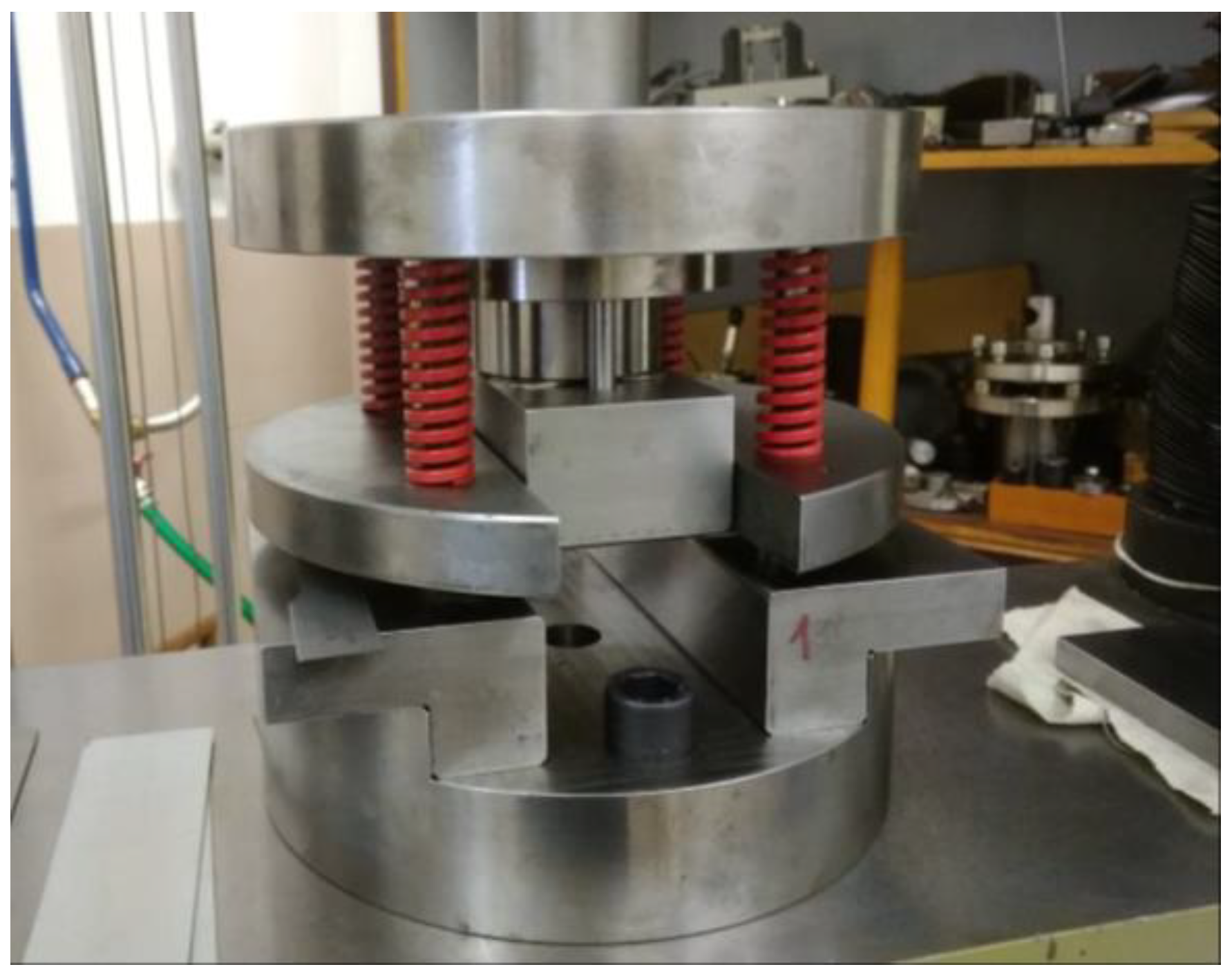
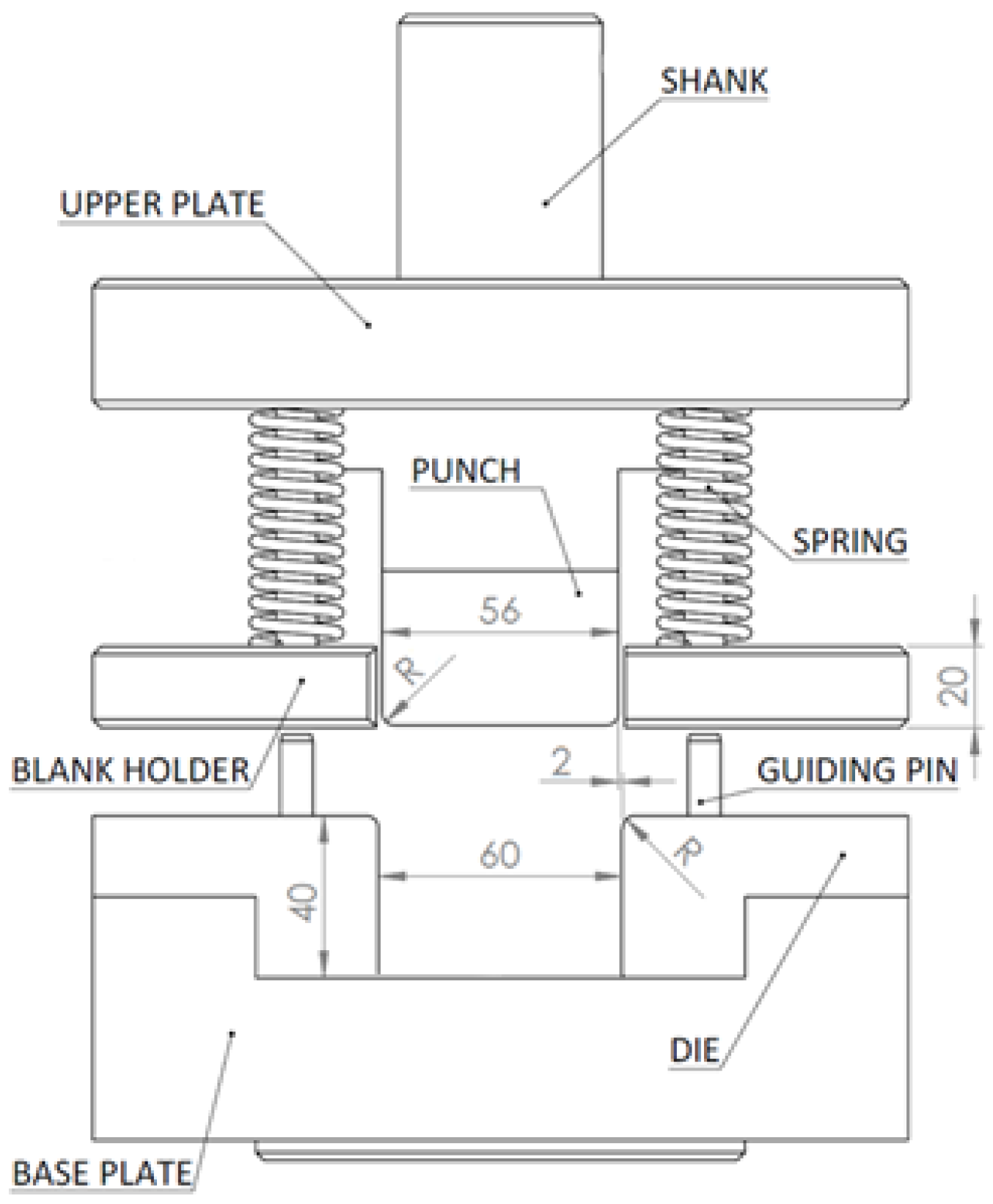

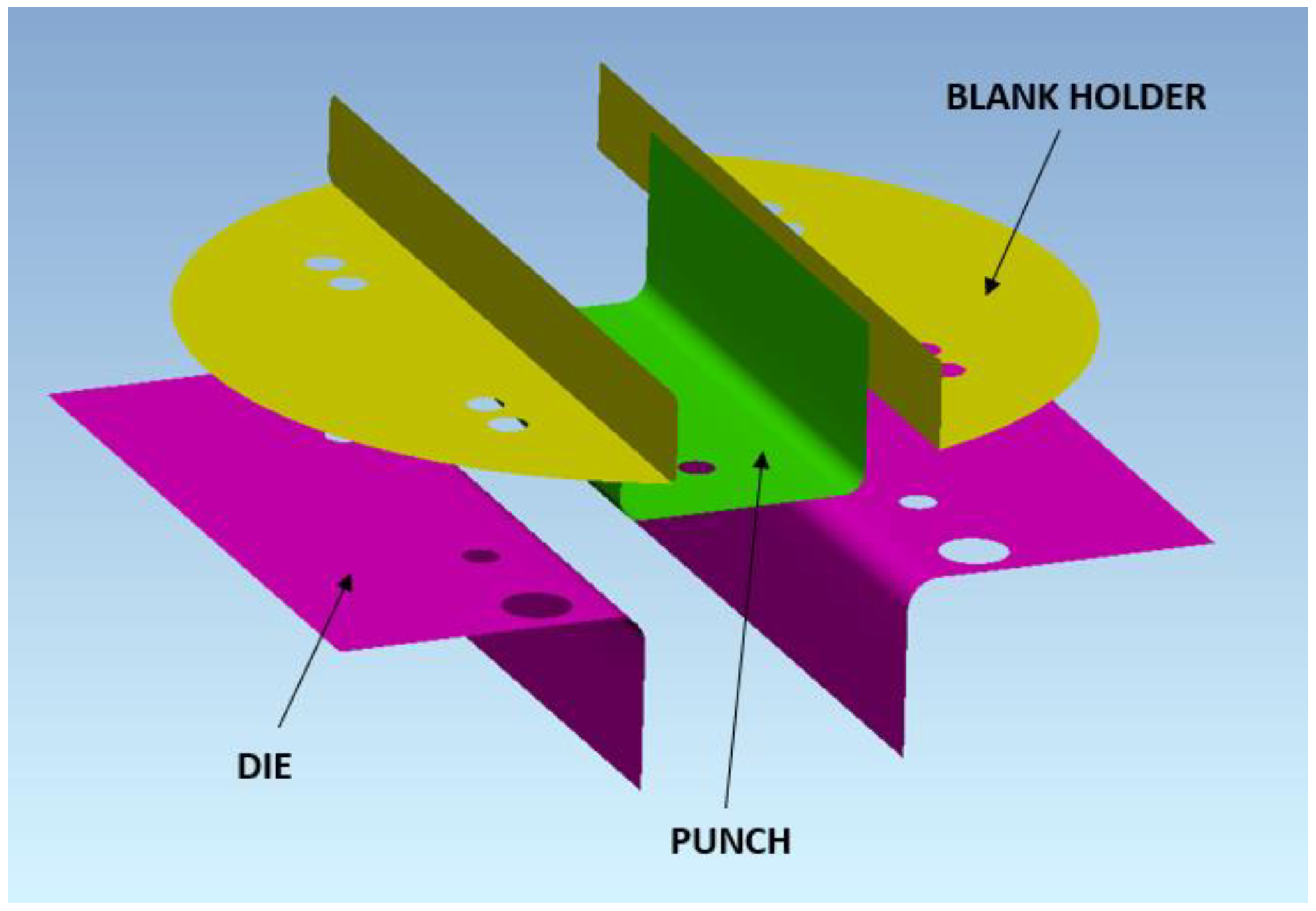



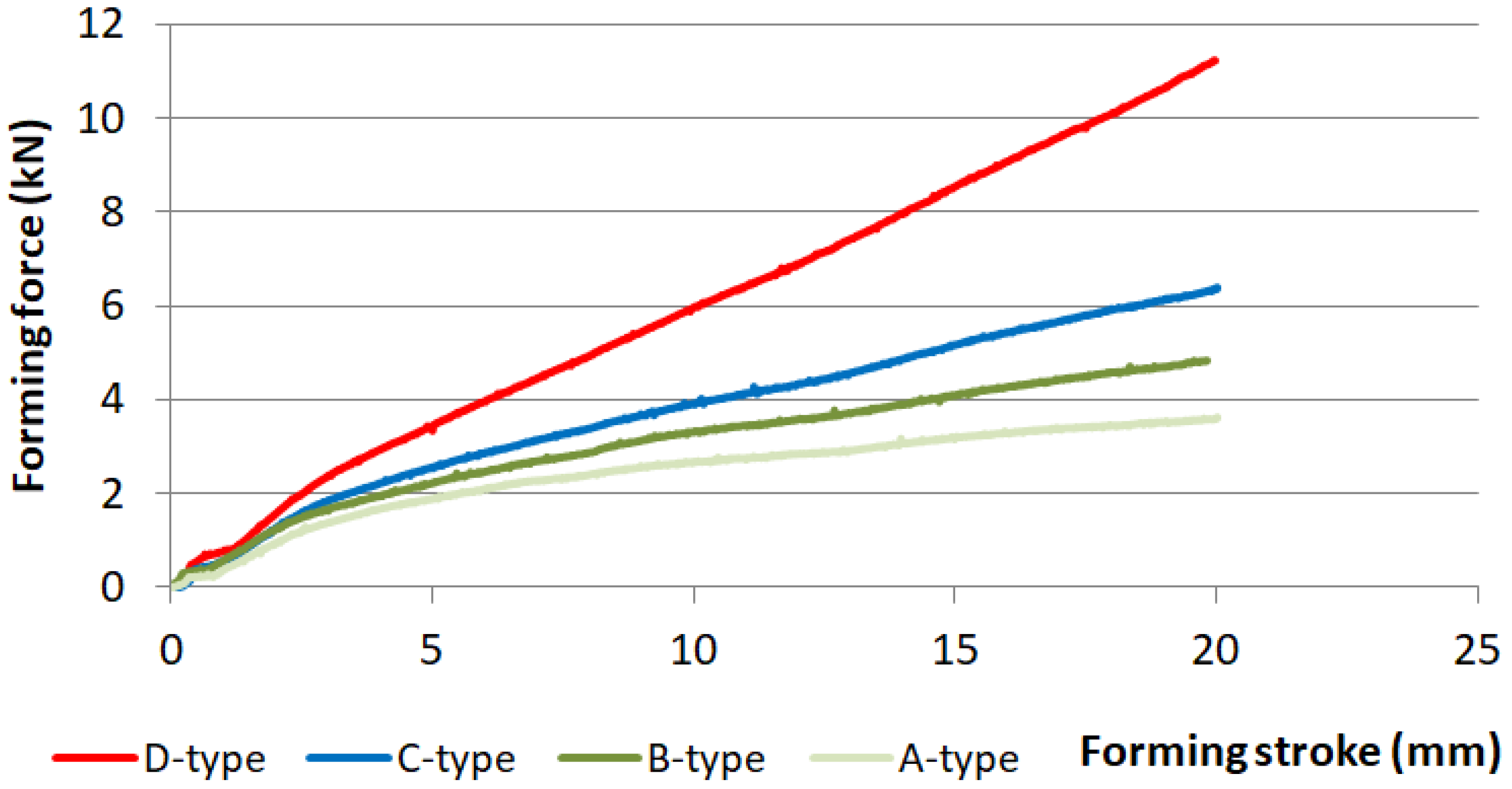
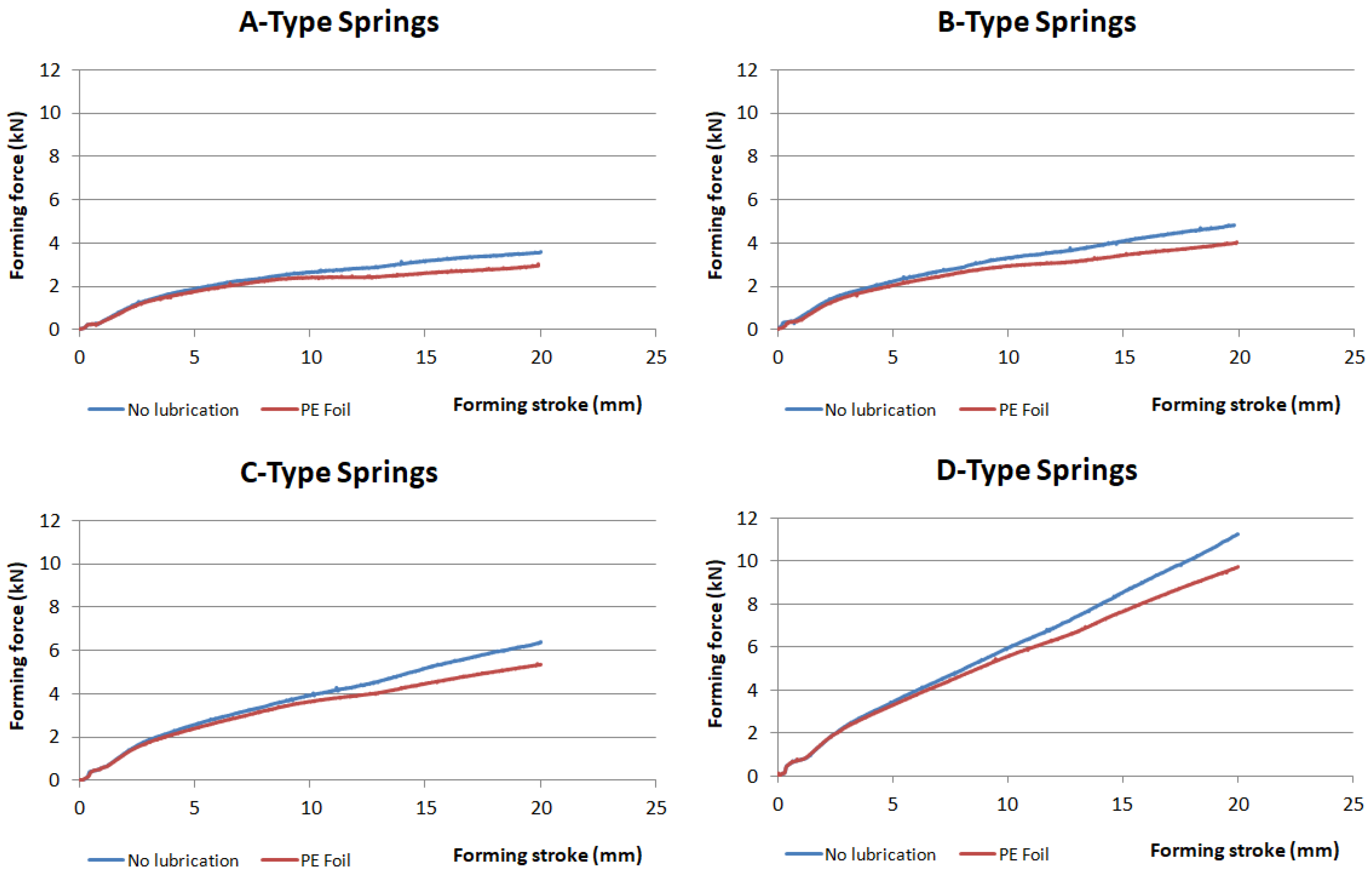

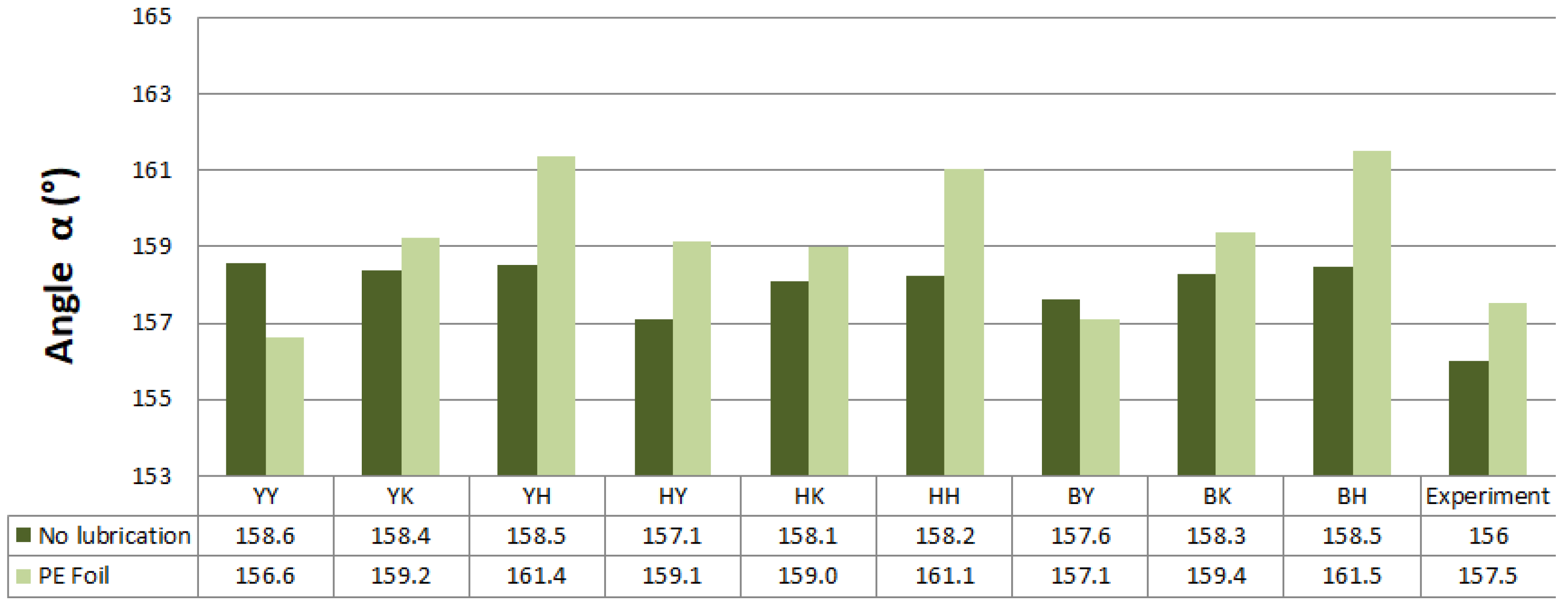
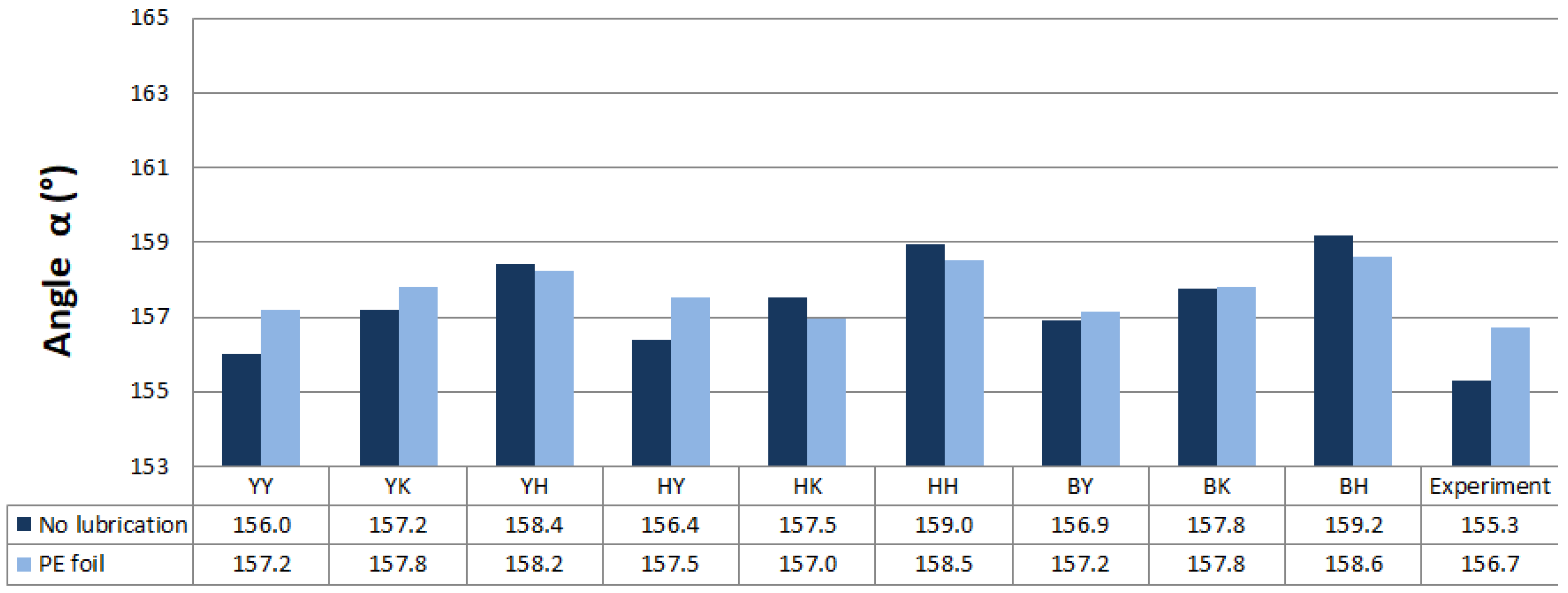
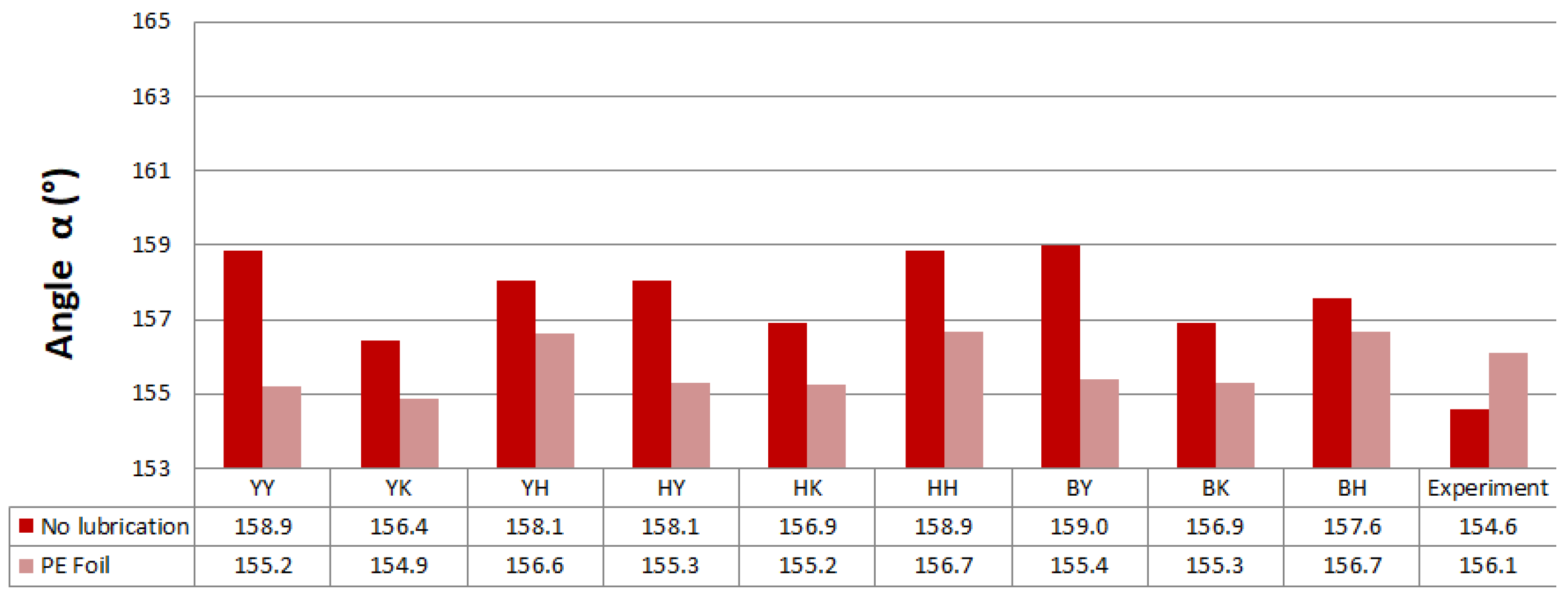
| Dir. [°] | E [GPa] | Rp0.2 [MPa] | Rm [MPa] | A80 [%] | r [-] | rm [-] | n [-] | nm [-] |
|---|---|---|---|---|---|---|---|---|
| 0 | 405 | 656 | 24.4 | 0.745 | 0.197 | |||
| 45 | 199 | 423 | 661 | 22.3 | 0.883 | 0.862 | 0.186 | 0.188 |
| 90 | 430 | 670 | 25.5 | 0.934 | 0.183 |
| Spring Type | FBHI (kN) | FBHM (kN) | Maximum Allowed Compression (mm) |
|---|---|---|---|
| A | 0.10 | 0.35 | 32.0 |
| B | 0.15 | 0.53 | 25.6 |
| C | 0.20 | 0.80 | 24.0 |
| D | 0.30 | 1.30 | 19.2 |
| r0 (-) | r45 (-) | r90 (-) | σ0 (MPa) | σ45 (MPa) | σ90 (MPa) | σbiax (-) |
|---|---|---|---|---|---|---|
| 0.745 | 0.883 | 0.934 | 405 | 423 | 430 | 1.04 |
| Model | K (MPa) | n (-) | φ0 (-) |
|---|---|---|---|
| Hollomon | 1 041 | 0.165 | - |
| Krupkowski | 1 040 | 0.168 | 0.0036 |
| Y(MPa) | a0 (-) | C1 (-) | C2 (-) | b (-) | m (-) | Rsat (-) | h (-) |
|---|---|---|---|---|---|---|---|
| 405 | 108.6 | 115.9 | 215.24 | 171.87 | 8.24 | 182.30 | 0.36 |
| Spring Type | α (°) | FF (kN) |
|---|---|---|
| A | 157.1 | 3.60 |
| B | 156.0 | 4.83 |
| C | 155.3 | 6.38 |
| D | 154.6 | 11.25 |
| Spring Type | α (°) | FF (kN) |
|---|---|---|
| A | 158.8 | 2.98 |
| B | 157.5 | 4.05 |
| C | 156.7 | 5.34 |
| D | 156.1 | 9.72 |
| Abbreviation | Yield Criterion | Hardening Rule | Hardening |
|---|---|---|---|
| YY | Yoshida | Yoshida-Uemori | isotropic-kinematic |
| YK | Yoshida | Krupkowski | isotropic |
| YH | Yoshida | Hollomon | isotropic |
| HY | Hill48 | Yoshida-Uemori | isotropic-kinematic |
| HK | Hill48 | Krupkowski | isotropic |
| HH | Hill48 | Hollomon | isotropic |
| BY | Barlat2000 | Yoshida-Uemori | isotropic-kinematic |
| BK | Barlat2000 | Krupkowski | isotropic |
| BH | Barlat2000 | Hollomon | isotropic |
| Lubrication | Parameter | YY | YK | YH | HY | HK | HH | BY | BK | BH | Experiment |
|---|---|---|---|---|---|---|---|---|---|---|---|
| no | β (°) | 21.6 | 22.1 | 21.0 | 20.1 | 22.3 | 21.3 | 20.6 | 22.0 | 20.9 | 22.9 |
| Dev β (%) | −5.7 | −3.7 | −8.4 | −12.4 | −2.8 | −7.2 | −10.1 | −4.0 | −8.9 | - | |
| yes | β (°) | 18.9 | 17.7 | 16.6 | 18.3 | 18.0 | 17.4 | 18.7 | 17.7 | 16.9 | 21.2 |
| Dev β (%) | −11.1 | −16.7 | −21.8 | −13.5 | −15.2 | −18.0 | −11.9 | −16.4 | −20.5 | - |
| Lubrication | Parameter | YY | YK | YH | HY | HK | HH | BY | BK | BH | Experiment |
|---|---|---|---|---|---|---|---|---|---|---|---|
| no | β (°) | 21.4 | 21.6 | 21.5 | 22.9 | 21.9 | 21.8 | 22.4 | 21.7 | 21.5 | 24.0 |
| Dev β (%) | −10.7 | −9.9 | −10.6 | −4.6 | −8.8 | −9.3 | −6.8 | −9.6 | −10.3 | - | |
| yes | β (°) | 23.4 | 20.8 | 18.7 | 20.9 | 21.0 | 19.0 | 22.9 | 20.7 | 18.5 | 22.5 |
| Dev β (%) | 4.0 | −7.6 | −17.1 | −7.3 | −6.7 | −15.8 | 1.9 | −8.2 | −17.7 | - |
| Lubrication | Parameter | YY | YK | YH | HY | HK | HH | BY | BK | BH | Experiment |
|---|---|---|---|---|---|---|---|---|---|---|---|
| no | β (°) | 24.0 | 22.8 | 21.6 | 23.6 | 22.5 | 21.0 | 23.1 | 22.2 | 20.8 | 24.7 |
| Dev β (%) | −2.8 | −7.7 | −12.7 | −4.5 | −9.0 | −14.8 | −6.5 | −10.0 | −15.7 | - | |
| yes | β (°) | 22.8 | 22.2 | 21.8 | 22.5 | 22.9 | 21.5 | 22.9 | 22.2 | 21.4 | 23.3 |
| Dev β (%) | −2.0 | −4.7 | −6.5 | −3.5 | −1.9 | −7.7 | −1.9 | −4.7 | −8.2 | - |
| Lubrication | Parameter | YU | YK | YH | HY | HK | HH | BY | BK | BH | Experiment |
|---|---|---|---|---|---|---|---|---|---|---|---|
| no | β (°) | 21.1 | 23.6 | 21.9 | 22.0 | 23.1 | 21.2 | 21.0 | 23.1 | 22.4 | 25.4 |
| Dev β (%) | −16.8 | −7.2 | −13.6 | −13.6 | −9.0 | −16.7 | −17.3 | −9.0 | −11.7 | - | |
| yes | β (°) | 24.8 | 25.1 | 23.4 | 24.7 | 24.8 | 23.3 | 24.6 | 24.7 | 23.3 | 23.9 |
| Dev β (%) | 3.8 | 5.1 | −2.3 | 3.4 | 3.6 | −2.3 | 3.1 | 3.3 | −2.4 | - |
Disclaimer/Publisher’s Note: The statements, opinions and data contained in all publications are solely those of the individual author(s) and contributor(s) and not of MDPI and/or the editor(s). MDPI and/or the editor(s) disclaim responsibility for any injury to people or property resulting from any ideas, methods, instructions or products referred to in the content. |
© 2023 by the authors. Licensee MDPI, Basel, Switzerland. This article is an open access article distributed under the terms and conditions of the Creative Commons Attribution (CC BY) license (https://creativecommons.org/licenses/by/4.0/).
Share and Cite
Mulidrán, P.; Spišák, E.; Tomáš, M.; Majerníková, J.; Bidulská, J.; Bidulský, R. Impact of Blank Holding Force and Friction on Springback and Its Prediction of a Hat-Shaped Part Made of Dual-Phase Steel. Materials 2023, 16, 811. https://doi.org/10.3390/ma16020811
Mulidrán P, Spišák E, Tomáš M, Majerníková J, Bidulská J, Bidulský R. Impact of Blank Holding Force and Friction on Springback and Its Prediction of a Hat-Shaped Part Made of Dual-Phase Steel. Materials. 2023; 16(2):811. https://doi.org/10.3390/ma16020811
Chicago/Turabian StyleMulidrán, Peter, Emil Spišák, Miroslav Tomáš, Janka Majerníková, Jana Bidulská, and Róbert Bidulský. 2023. "Impact of Blank Holding Force and Friction on Springback and Its Prediction of a Hat-Shaped Part Made of Dual-Phase Steel" Materials 16, no. 2: 811. https://doi.org/10.3390/ma16020811
APA StyleMulidrán, P., Spišák, E., Tomáš, M., Majerníková, J., Bidulská, J., & Bidulský, R. (2023). Impact of Blank Holding Force and Friction on Springback and Its Prediction of a Hat-Shaped Part Made of Dual-Phase Steel. Materials, 16(2), 811. https://doi.org/10.3390/ma16020811








